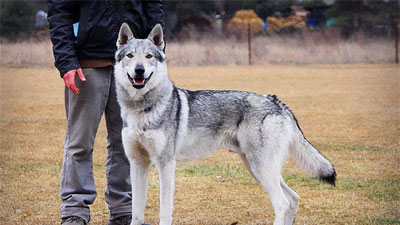- Size
- Smallest
- Small
- Small to Medium
- Medium
- Large
- Giant
- Characteristics
- Smartest
- Hypoallergenic
- Fluffy
- Best Guard
- Best Family
- Best for Kids
- Low Shedding
- Healthiest
- Police Dogs
- Most Calm
- Quietest
- Color
- White
- Black
- Grey
- Brown
- Blue
- Red
- Coat
- Hairless
- Short
- Long
- Origin
- Japan
- China
- Australia
- Germany
- Italy
- United States
- France
- Group
- Hound
- Terrier
- Herding
- Toy
- Working
- Sporting
Why Won't My Dog Learn To "Stand" Command?

Photo by Christoph Schmid on Unsplash
If you find yourself asking, "Why won't my dog learn to stand?", you are not alone. Teaching your dog new tricks can be a rewarding and bonding experience, but sometimes certain behaviors can present challenges. In this article, we will explore the possible reasons why your dog may struggle to learn the stand command and discuss effective solutions to help them understand and master this important skill.
The Importance of Teaching "Stand"
The stand command is a fundamental behavior that every dog should learn. It serves various practical purposes, such as during grooming or veterinary exams, where your dog needs to remain still and upright. Additionally, teaching your dog to stand can be useful for obedience, agility, and other advanced training activities.
Common Challenges in Teaching "Stand"
Several factors may contribute to your dog's difficulty in learning the stand command. Let's examine some of the most common challenges:
1. Lack of Clear Communication: Dogs rely on clear and consistent communication to understand commands. If your instructions are unclear or inconsistent, your dog may become confused or unsure of what is expected of them.
2. Insufficient Motivation: Dogs are more likely to learn and repeat behaviors that are rewarding. If the rewards you're offering during training sessions are not enticing enough, your dog may lose interest and struggle to grasp the stand command.
3. Physical Discomfort or Pain: Certain medical conditions, aging, or discomfort can make it difficult for dogs to maintain a standing position. Physical limitations may hinder their ability to perform the command and lead to frustration or reluctance.
4. Fear or Anxiety: Dogs that are fearful or anxious may find it challenging to stand still. This could be due to past traumatic experiences, lack of socialization, or general anxiety. Fearful dogs may exhibit avoidance behaviors, making it harder for them to learn commands.
5. Lack of Foundation Training: Dogs may struggle with the stand command if they have not been properly introduced to basic obedience training or lack sufficient foundation skills. It's important to ensure that your dog has mastered commands like sit and stay before moving on to more advanced behaviors.
Solutions for Teaching "Stand"
Now that we've identified some of the challenges, let's explore effective solutions to help your dog learn the stand command:
1. Clear Communication: Consistency is key when teaching any command. Use a clear and distinct verbal cue, such as "stand" or "up," and pair it with a visual hand signal to reinforce your message. Use the same cues each time, ensuring that everyone in the household uses the same commands and signals.
2. Motivating Rewards: Discover what motivates your dog the most and use those rewards during training sessions. This could be high-value treats, praise, play, or a combination of these. Make training fun and engaging to keep your dog's interest high.
3. Address Physical Limitations: If you suspect that physical discomfort or pain is hindering your dog from standing, consult with your veterinarian. They can conduct a thorough examination to rule out any underlying medical issues. If necessary, your vet may recommend pain management or physical therapy to assist with your dog's mobility.
4. Counterconditioning and Desensitization: For dogs struggling with fear or anxiety, a professional dog trainer or behaviorist can help develop a desensitization and counterconditioning plan. Gradually exposing your dog to their fear triggers in a controlled and positive manner can help them overcome their anxieties and become more receptive to learning the stand command.
5. Back to Basics: If your dog is struggling with the stand command, it may be beneficial to review and reinforce their foundation training. Ensure that they have a solid understanding of basic obedience commands like sit and stay before introducing more complex behaviors.
6. Patience and Consistency: Rome wasn't built in a day, and neither is a well-trained dog. Remember that learning takes time and patience. Break down the stand command into smaller steps, rewarding each small success along the way. Consistent practice and positive reinforcement will help your dog understand and perform the stand command reliably.
7. Seek Professional Help: If you're consistently facing challenges in teaching your dog to stand, seeking professional help is a wise decision. Professional dog trainers and behaviorists can provide personalized guidance and training plans tailored to your dog's specific needs.
Conclusion
While teaching your dog to stand can be frustrating at times, understanding the challenges and implementing effective solutions will greatly improve your training experience. By maintaining clear communication, providing motivation, addressing physical limitations or fear, reinforcing foundational training, and seeking professional help when needed, you'll set your dog up for success. Remember, consistency, patience, and positive reinforcement are crucial in helping your furry friend learn the stand command and other valuable behaviors.
You May Also Like
 Dog Training TipsHow To Train Your Dog To Eye Contact
Dog Training TipsHow To Train Your Dog To Eye Contact Dog Training TipsThe 'Stand' Command: A Crucial Yet Overlooked Training Cue
Dog Training TipsThe 'Stand' Command: A Crucial Yet Overlooked Training Cue Dog Training TipsThe 'Wait' Command: Teaching Your Dog Patience and Discipline
Dog Training TipsThe 'Wait' Command: Teaching Your Dog Patience and Discipline Dog Training TipsThe Place Command: Teach Your Dog to Go to Their Place
Dog Training TipsThe Place Command: Teach Your Dog to Go to Their Place Dog Training TipsDog Tricks: Teach Your Dog to High Five
Dog Training TipsDog Tricks: Teach Your Dog to High Five Dog Training TipsTeaching Your Dog the Classic Trick: Shake Hands
Dog Training TipsTeaching Your Dog the Classic Trick: Shake Hands